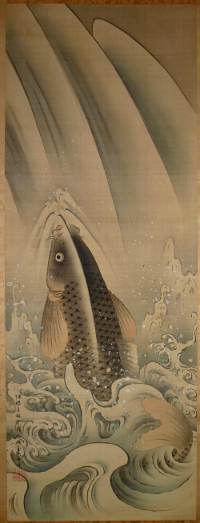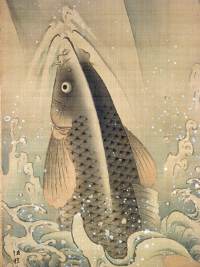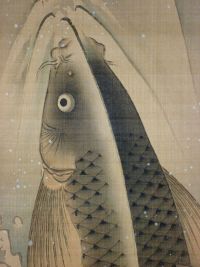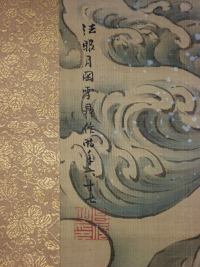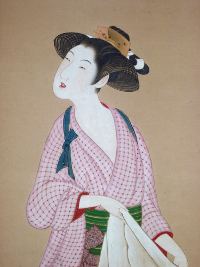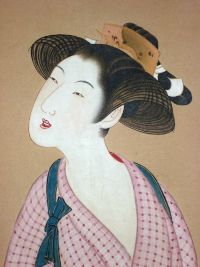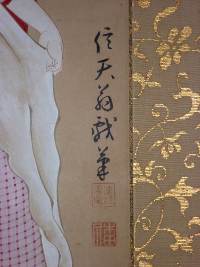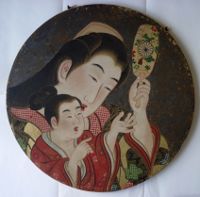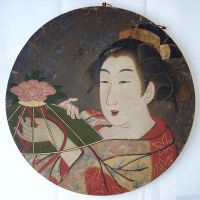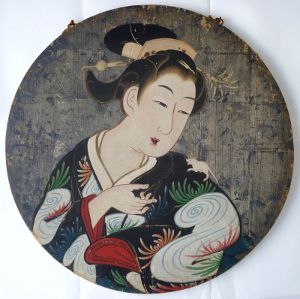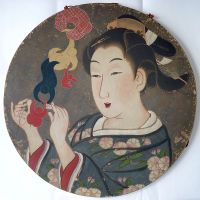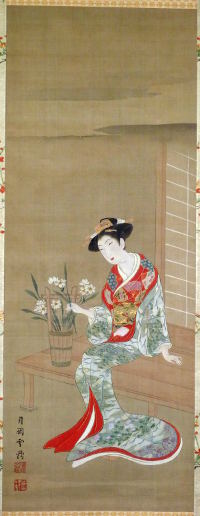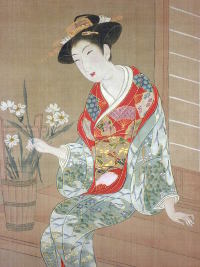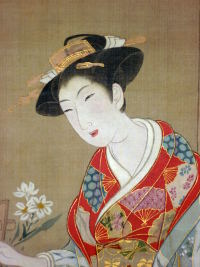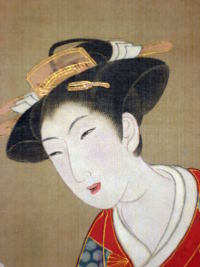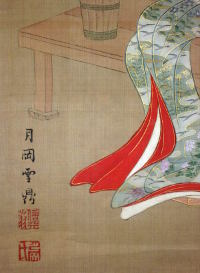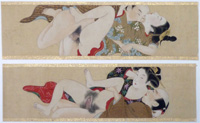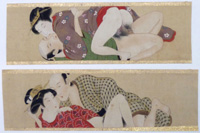Tsukioka SETTEI (1710-1786)

Click here to view image full size.
An original painting, sumi and full colour on silk, 38 x 12.5 in; 96 x 32 cms. Settei produced many illustrated books but after around 1765 turned towards painting beauties, courtesans and geishas. They are of the utmost refinement – the faces and limbs often delineated in red and their costumes embellished with gold. Settei is also known for his elegant shunga. A beauty looks towards a weeping willow. Painted c 1770. In good condition with an elaborately stencilled and embroidered mount. Details picked out in gold.
Signed Hokkyo Tsukioka Settei dzu and sealed o’Shinten.
Status: Available
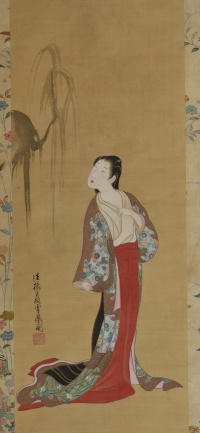
Click here to view image full size.
Tsukioka SETTEI (1710-1786)
Click here to view image full size.
An original painting, sumi and light blue on silk. Image size 38.75 x 14.25 in; 98.4 x 36.2 cms. Shows a carp leaping a waterfall. This was a favourite subject for Japanese artists being a symbol of achievement against adversity. Carp were bred for their colour in Japan and, interestingly, Koi that are returned to the wild revert back to their grey colour. They are known to live for up to a hundred years or more. Settei produced many illustrated books but after around 1765 turned to painting beauties, courtesans and geishas. They are of the utmost refinement – the faces and limbs picked out in red, their costumes with areas of gold, and invariably have the wide lantern-locks (toro-bin) hairstyle. Signed Hogen Tsukioka Sessai jinen rokuju-nana (painted aged sixty-seven, hence 1777). Seal Masanobu no in. In good condition with splashed gofun.
Status: Sold
Tsukioka SETTEI (1710-1786)
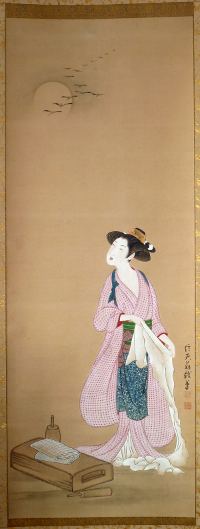
Click here to view image full size.
A very fine large painting showing a standing beauty holding a cloth. At her feet is a fulling-block (kinuta) and several mallets. She looks skyward at the geese flying across the moon. One of the traditional symbols of autumn in Japan. There seems to have been a frisson in depicting these beauties fulling cloth near streams, as well as awabi divers and the women of Ohara collecting faggots. Settei produced many illustrated books but after around 1765 turned to painting beauties, courtesans and geishas. They are of the utmost refinement – the faces and limbs picked out in red, their costumes with areas of gold, and invariably have the wide lantern-locks (toro-bin) hairstyle. All these characteristics are found here. Full colour on paper, image size 48.75 x 18.25; 124 x 47.5 cms. Painting and mount in extremely good condition. The box comes with a registration form showing the work seems to have been put up for sale at the Tokyo Bijutsu Club in Tokyo about 70 or 80 years ago. Painted c 1770. Signed Shinten’o gihitsu (painted for amusement by Shinten’o). Seals Hokkyo Settei and Kidashi (family name).
Status: Sold
Tsukioka SETTEI (1710-1786)
Click here to view image full size.
An interesting large painting, full colour on paper mounted on a wooden frame, 25.5 in; 62cms in diameter showing a bust portrait of a beauty with elaborate coiffure holding a child and a rattle. Although not signed, the attribution is unquestionable, painted between 1767-1773 in Osaka. It appears to have been commissioned to hang in a hairdresser’s or cosmetic shop and has metal eyes at the top. The oxidised silver leaf background was meant to resemble a mirror and the idea of busts reflected in mirrors and silver grounds was later employed by Utamaro and Sharaku. Apart from silver, gold leaf and gum is applied. Such signboards appear in an illustrated book by Hasegawa Mitsunobu published in Osaka in 1752. This new discovery has been written about by Dr. Yamamoto Yukari in vol.27 of Minzoku Geijutsu (Ethno-Arts) in 2011. Minor surface marks all over but astonishingly good condition given their age and use. Extremely rare.
Status: Sold
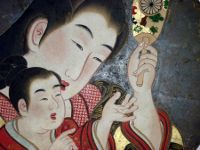
Click here to view image full size.
Tsukioka SETTEI (1710-1786)
Click here to view image full size.
An interesting large painting, full colour on paper mounted on a wooden frame, 25.5 in; 62cms in diameter showing a bust portrait of a beauty with elaborate coiffure and holding a hat for a street festival. Although not signed, the attribution is unquestionable, painted between 1767-1773 in Osaka. It appears to have been commissioned to hang in a hairdresser’s or cosmetic shop and has metal eyes at the top. The oxidised silver leaf background was meant to resemble a mirror and the idea of busts reflected in mirrors and silver grounds was later employed by Utamaro and Sharaku. Besides silver, gum and raised painting is applied. Such signboards appear in an illustrated book by Hasegawa Mitsunobu published in Osaka in 1752. This new discovery has been written about by Dr. Yamamoto Yukari in vol.27 of Minzoku Geijutsu (Ethno-Arts) in 2011. Minor surface marks all over but astonishingly good condition given their age and use. Extremely rare.
Status: Available
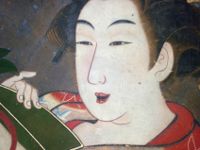
Click here to view image full size.
Tsukioka SETTEI (1710-1786)
Click here to view image full size.
An interesting large painting, full colour on paper mounted on a wooden frame, 25.5 in; 62cms in diameter showing a bust portrait of a beauty with elaborate coiffure and a white mouse. Although not signed, the attribution is unquestionable, painted between 1767-1773 in Osaka. It appears to have been commissioned to hang in a hairdresser’s or cosmetic shop and has metal eyes at the top. The oxidised silver leaf background was meant to resemble a mirror and the idea of busts reflected in mirrors and silver grounds was later employed by Utamaro and Sharaku. Besides silver, gum and raised painting is applied. Such signboards appear in an illustrated book by Hasegawa Mitsunobu published in Osaka in 1752. This new discovery has been written about by Dr. Yamamoto Yukari in vol.27 of Minzoku Geijutsu (Ethno-Arts) in 2011. Minor surface marks all over but astonishingly good condition given their age and use. Extremely rare.
Status: Sold
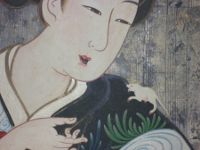
Click here to view image full size.
Tsukioka SETTEI (1710-1786)
Click here to view image full size.
An interesting large painting, full colour on paper mounted on a wooden frame, 25.5 in; 62cms in diameter showing a bust portrait of a beauty with elaborate coiffure hanging paper acrobats. Although not signed, the attribution is unquestionable, painted between 1767-1773 in Osaka. It appears to have been commissioned to hang in a hairdresser’s or cosmetic shop and has metal eyes at the top. The oxidised silver leaf background was meant to resemble a mirror and the idea of busts reflected in mirrors and silver grounds was later employed by Utamaro and Sharaku. Besides silver, gum and raised painting is applied. Such signboards appear in an illustrated book by Hasegawa Mitsunobu published in Osaka in 1752. This new discovery has been written about by Dr. Yamamoto Yukari in vol.27 of Minzoku Geijutsu (Ethno-Arts) in 2011. Minor surface marks all over but astonishingly good condition given their age and use. Extremely rare.
Status: Sold
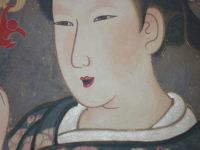
Click here to view image full size.
Tsukioka SETTEI ( 1710-1786 )
Click here to view image full size.
An original painting showing a beauty sitting on an engawa having picked flowers which she is placing in a wooden bucket beside her. Settei produced many illustrated books but after around 1765 turned towards painting beauties, courtesans and geishas. They are of the utmost refinement – the faces and limbs picked out in red, their costumes often having areas of gold, and invariably have the wide lantern-locks ( toro-bin ) hairstyle. Settei also excelled at shunga painting. Sumi and full colour with details picked out in gold on silk. 30.75 x 11.5 in; 78.1 x 29.2 cms. Minor creasing but otherwise very good condition. An elaborately embroidered mount. Painted c 1770. Signed Tsukioka Settei with seals Shinten’o and Tsukioka shi.
Status: Sold
Tsukioka SETTEI (1710-1786)
Four original paintings on silk. An artist who developed a style somewhere between Moronobu and Sukenobu. Well known for his elegant erotica painted with great refinement. Sizes vary from 3.25 in; 5.5 cms. x 12.75 in; 32.5 cms. to 3.25 in; 5.5 cms. x 11.5 in; 29 cms. Full colour and obviously taken from a hand scroll of 12 such paintings. Mounted onto gold-flecked paper. Unsigned.
Status: Sold
